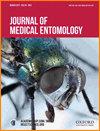气候变化对哥伦比亚具有公共卫生意义的蜱虫地理分布的影响:Amblyomma ovale (Ixodida: Ixodidae), the Amblyomma maculatum (Ixodida: Ixodidae) complex and the Amblyomma cajennense (Ixodida: Ixodidae) complex
IF 2
3区 农林科学
Q1 ENTOMOLOGY
引用次数: 0
摘要
据了解,Amblyomma maculatum(Ixodida Ixodidae)复合体、Amblyomma cajennense(Ixodida Ixodidae)复合体和Amblyomma ovale(Ixodida Ixodidae)的蜱虫会在哥伦比亚传播各种立克次体,但它们的确切分布情况尚不清楚。我们采用最大熵方法,根据当前气候建立了几个模型,并预测了未来的气候变化。我们共获得了 314 条记录,包括 A. cajennense 复合体(65.9%;n = 207)、A. ovale(22.9%;n = 72)和 A. maculatum 复合体(11.1%;n = 35)。目前,Amblyomma ovale分布在太平洋、加勒比海和安第斯地区,并有可能在亚马逊地区发现。Amblyomma maculatum 目前分布在安第斯地区,有可能在加勒比海和奥里诺科地区发现。Amblyomma mixtum分布在加勒比海附近和太平洋地区,而A. patinoi则可能分布在安第斯地区和加勒比海地区。到 2070 年,卵形瘤蚁和巨型瘤蚁的数量可能会增加,而 mixtum 和 patinoi 的数量可能会减少。最能预测这些物种分布的变量是等温线(温度波动小)和年降水量。Amblyomma cajennense s.l和A. ovale、A. cajennese s.l和A. patinoi以及A. maculatum和A. patinoi具有重要的环境共生关系。流行病学和昆虫学监测对于调查由 R. parkeri 在 A. ovale 地区、由 R. rickettsii 在 A. patinoi 和 A. mixtum 地区以及由 R. parkeri s.s 在 A. maculatum 地区引起的立克次体病至关重要。本文章由计算机程序翻译,如有差异,请以英文原文为准。
Impact of climate change on the geographical distribution of ticks of public health significance in Colombia: Amblyomma ovale (Ixodida: Ixodidae), the Amblyomma maculatum (Ixodida: Ixodidae) complex and the Amblyomma cajennense (Ixodida: Ixodidae) complex
Ticks of the Amblyomma maculatum (Ixodida Ixodidae) complex, the Amblyomma cajennense (Ixodida Ixodidae) complex and Amblyomma ovale (Ixodida Ixodidae) are known to transmit various Rickettsia species in Colombia, but their exact distribution is unknown. We built several models based on current climate and projected future climate changes using a maximum entropy approach. A total of 314 records of the A. cajennense complex (65.9%; n = 207), A. ovale (22.9%; n = 72), and the A. maculatum complex (11.1%; n = 35) were obtained. Amblyomma ovale has a current distribution in the Pacific, Caribbean and Andean regions and could be potentially found in the Amazon. Amblyomma maculatum has a current distribution in the Andean and could potentially be found in the Caribbean and Orinoco regions. Amblyomma mixtum can be found near the Caribbean Sea and in the Pacific region, and A. patinoi is likely to be found in the Andean region and the Caribbean. In 2070, it will be possible to find an expansion of A. ovale and A. maculatum and a decrease of A. mixtum and A. patinoi. The variables that best predict the distribution of these species are isothermality (small fluctuations in temperature) and annual precipitation. Amblyomma cajennense s.l and A. ovale, A. cajennese s.l and A. patinoi, as well as A. maculatum and A. patinoi, have an important environmental sympatry. Epidemiological and acarological surveillance is crucial to investigate rickettsiosis caused by R. parkeri in A. ovale regions, by R. rickettsii in A. patinoi and A. mixtum areas, and by R. parkeri s.s in A. maculatum regions.
求助全文
通过发布文献求助,成功后即可免费获取论文全文。
去求助
来源期刊
CiteScore
4.60
自引率
14.30%
发文量
207
审稿时长
3-8 weeks
期刊介绍:
Journal of Medical Entomology is published bimonthly in January, March, May, July, September, and November. The journal publishes reports on all phases of medical entomology and medical acarology, including the systematics and biology of insects, acarines, and other arthropods of public health and veterinary significance. In addition to full-length research articles, the journal publishes Reviews, interpretive articles in a Forum section, Short Communications, and Letters to the Editor.

 求助内容:
求助内容: 应助结果提醒方式:
应助结果提醒方式:


